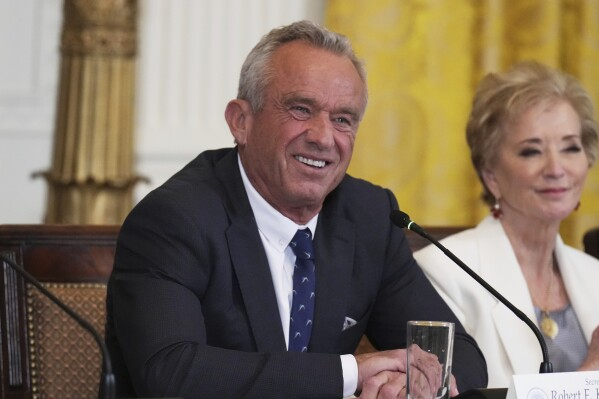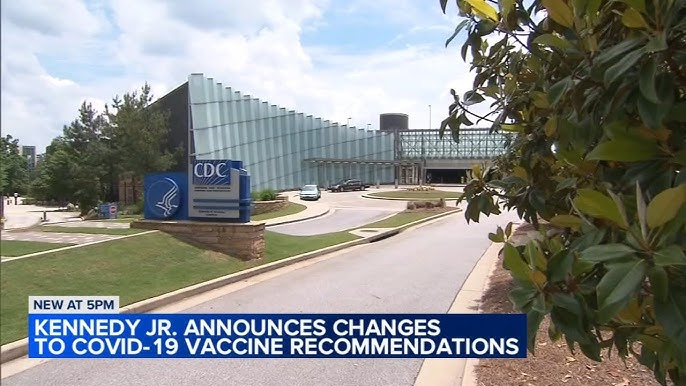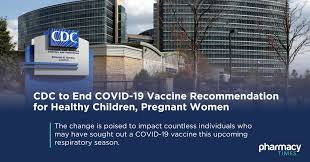In a surprising move, the Centers for Disease Prevention and Control (CDC) has announced that the COVID-19 vaccine is no longer recommended for healthy children and pregnant women as part of its standard immunization schedules. This decision, effective as of May 27, 2025, has sparked widespread discussion across the United States, with reactions ranging from celebration to skepticism. The policy shift reflects evolving scientific evidence, changing public health priorities, and ongoing debates about vaccine necessity for certain groups. Let’s dive into what this change means, why it happened, and how it’s being received.

Why Did the CDC Make This Change?
The decision to remove the COVID-19 vaccine from the recommended schedules for healthy children and pregnant women comes after months of review by the CDC, the Department of Health and Human Services (HHS), the National Institutes of Health (NIH), and the Food and Drug Administration (FDA). According to statements from health officials, the move is based on updated data showing that the risk of severe COVID-19 outcomes in healthy children and pregnant women is significantly lower than previously thought. With the virus now considered endemic in many areas, the focus of public health strategies has shifted toward targeted protection for high-risk groups, such as the elderly and immunocompromised individuals.
A key factor in this decision is the growing body of evidence suggesting that natural immunity, acquired through prior infection, plays a significant role in protecting healthy individuals from severe outcomes. Studies have shown that children, in particular, often experience mild or asymptomatic cases of COVID-19, reducing the perceived need for routine vaccination in this group. Similarly, for healthy pregnant women, the risk-benefit analysis of vaccination has been reassessed, with new data indicating that the vaccine’s benefits may not outweigh potential concerns for this population in the current context of the pandemic.
The CDC’s Advisory Committee on Immunization Practices (ACIP) reviewed these findings during a series of meetings in early 2025. While the vaccine remains available for those who choose it, the CDC emphasized that its removal from the recommended schedule does not mean it is unsafe. Instead, it reflects a tailored approach to vaccination, prioritizing those at higher risk while reducing mandates for groups less likely to experience severe illness. For more details on the CDC’s decision-making process, you can visit their official statement on the CDC’s ACIP page.
What Does This Mean for Families and Pregnant Women?
For parents of healthy children and expectant mothers, this change introduces new considerations. The CDC’s updated guidance means that pediatricians and healthcare providers are no longer required to recommend the COVID-19 vaccine as part of routine care for these groups. However, families can still opt for the vaccine if they believe it’s necessary, especially in cases where children or pregnant women have underlying health conditions that increase their risk of severe COVID-19.

This shift may also affect school and daycare policies, as many institutions previously required proof of COVID-19 vaccination for attendance. With the vaccine no longer on the CDC’s recommended schedule, some states may revise their mandates, potentially easing requirements for unvaccinated children. However, policies vary widely by state and school district, so parents should check local regulations. The American Academy of Pediatrics has published resources to help families navigate these changes, available on their COVID-19 guidance page.
For pregnant women, the decision raises questions about prenatal care and vaccine choices. While the vaccine was initially recommended to protect both mother and baby from severe outcomes, the CDC’s updated stance suggests that healthy pregnant women may not need it unless they face specific risk factors. Obstetricians are now tasked with providing individualized advice, balancing personal health histories with the latest public health guidance.
Public Reaction: A Divided Response
The announcement has elicited a wide range of reactions. Some Americans view the decision as a victory for personal choice and a step toward acknowledging the evolving nature of the pandemic. Posts on social media platforms like X have celebrated the move, with users describing it as a “big win” for reducing vaccine mandates and prioritizing individual health decisions. Others, however, express concern that the change could undermine public confidence in vaccines overall, particularly at a time when new COVID-19 variants continue to emerge.
Critics of the decision, including some public health advocates, argue that removing the vaccine from recommended schedules could lead to lower vaccination rates and potentially increase the risk of outbreaks, especially in communities with low immunity. They point to the importance of maintaining herd immunity and protecting vulnerable populations. Meanwhile, supporters of the change, including prominent figures like Secretary Robert F. Kennedy Jr., have framed it as a correction to overly broad vaccine policies that may have pressured healthy individuals unnecessarily.
The debate has also reignited discussions about trust in public health institutions. Some Americans question the timing of the decision, wondering whether it reflects new science or political influences. To address these concerns, the CDC has pledged to continue monitoring COVID-19 trends and will reassess its recommendations if new evidence emerges. For a deeper look into public health policy debates, check out this analysis from Health Affairs.
What’s Next for COVID-19 Vaccination in the U.S.?
The removal of the COVID-19 vaccine from the recommended schedules for healthy children and pregnant women does not mean the end of COVID-19 vaccination efforts. The vaccine remains a critical tool for high-risk groups, including older adults, individuals with chronic conditions, and immunocompromised people. The CDC continues to recommend annual COVID-19 boosters for these populations, similar to flu shots, to protect against evolving variants.

Public health officials are also focusing on improving communication about vaccines. The CDC plans to launch educational campaigns to clarify that the vaccine is still safe and effective for those who need it most. Additionally, research into next-generation COVID-19 vaccines, including nasal sprays and universal coronavirus vaccines, is ongoing, with the hope of providing broader and longer-lasting protection.
For now, the CDC’s decision marks a pivot toward a more targeted approach to COVID-19 vaccination. As the pandemic continues to evolve, so too will the strategies to manage it. Families, healthcare providers, and policymakers will need to stay informed and adaptable as new data and recommendations emerge.
Final Thoughts
The CDC’s decision to remove the COVID-19 vaccine from the recommended schedules for healthy children and pregnant women is a significant moment in the ongoing response to the pandemic. It reflects a growing understanding of the virus, its risks, and the role of vaccines in a world where COVID-19 is no longer a public health emergency but a manageable part of life for many. While the change has sparked debate, it also underscores the importance of flexibility in public health policy. As always, individuals should consult with their healthcare providers to make informed decisions about vaccination based on their unique circumstances.
Stay updated on this topic by visiting trusted sources like the CDC, the American Academy of Pediatrics, and Health Affairs for the latest guidance and insights.
For you :- White House to Propose $9.4 Billion in Budget Cuts from Musk’s DOGE Efficiency Plan






